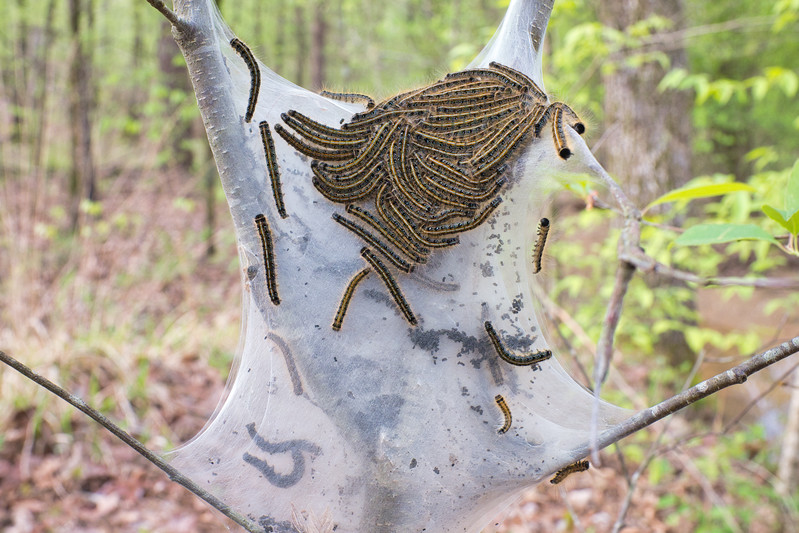As you hike through the scenic trails of Arkansas’ Ouachita National Forest, one forest dweller makes itself especially visible: the Eastern Tent Caterpillar. Though often labeled a pest, this small insect has a surprisingly big impact on the local ecosystem.

What Are Eastern Tent Caterpillars?
Eastern Tent Caterpillars are early spring insects known for building silky, web-like tents in the forks of tree branches. With black bodies and electric-blue streaks along their sides, they’re hard to miss. These caterpillars are social creatures, living communally and molting multiple times before transforming into moths.
Where You’ll Find Them
These caterpillars prefer deciduous trees like cherry, apple, and oak. In the Ouachita National Forest, they often appear on the edges of trails, their tents catching the morning light. While they may defoliate these trees, the damage is temporary. Most trees recover quickly, bursting into new growth within weeks.
Are They Bad for the Forest?
It’s easy to assume leaf loss harms a forest. However, that’s not the whole story. The Eastern Tent Caterpillar plays a role in nutrient cycling. By consuming leaves, they help break down plant material faster, enriching the soil. Additionally, their population supports a food web of birds, spiders, and parasitic wasps.
Nature’s Cleanup Crew
After feeding, caterpillars produce droppings that act as natural fertilizer. It’s not the prettiest process, but it’s essential for soil health. This hidden contribution makes them more friend than foe in forest ecology.
A Lesson in Resilience
Trees have evolved with these insects. Many native species are well-equipped to handle defoliation. In fact, it’s part of a natural cycle that stimulates new growth. Watching a seemingly damaged tree bounce back can be a powerful reminder of nature’s resilience.
Tips for Observing Eastern Tent Caterpillars
If you’re hiking or photographing in early spring:
- Look for white silk tents in trees, especially wild cherry.
- Early morning offers the best lighting for photos.
- Avoid disturbing the tents to keep the ecosystem intact.
Why Eastern Tent Caterpillars Matter
Despite their reputation, these caterpillars are more than just leaf-eaters. They offer insight into forest dynamics, insect behavior, and the delicate balance of natural life. For nature enthusiasts, casual hikers, educators, and wildlife photographers, they provide an accessible and fascinating subject.
FAQ
What do Eastern Tent Caterpillars eat?
They primarily feed on the leaves of deciduous trees like cherry, apple, and oak.
How long do Eastern Tent Caterpillars live?
From egg to moth, their life cycle lasts several weeks, with the caterpillar stage lasting about 4 to 6 weeks.
When is the best time to see Eastern Tent Caterpillars?
They are most active in early to mid-spring, usually from March to May.
Why do they build tents in trees?
The silk tents help them stay warm, avoid predators, and provide a central location for group activities.
Do Eastern Tent Caterpillars harm trees permanently?
No. Most healthy trees recover from defoliation and regrow leaves within weeks.
